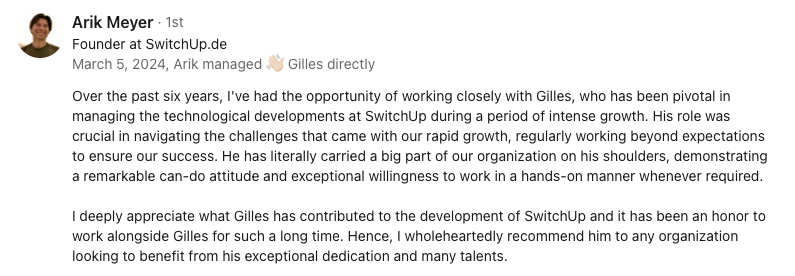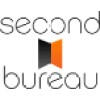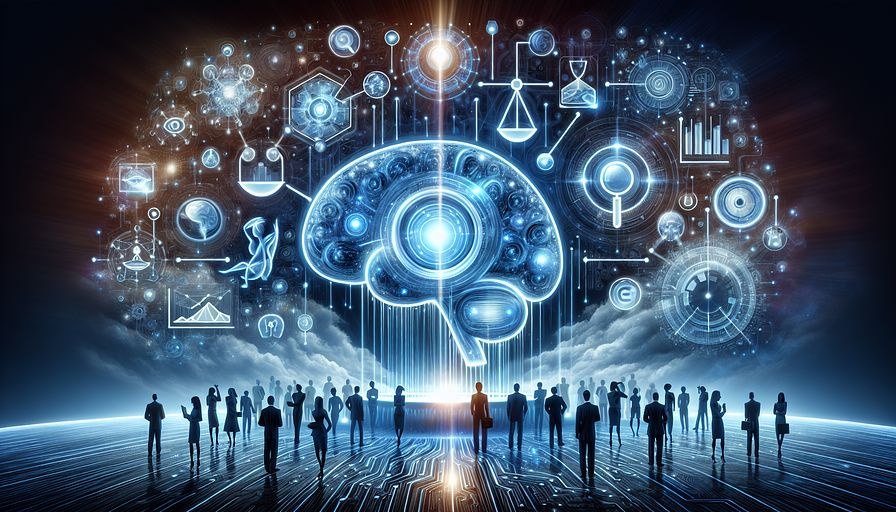Abstract:
The article explores the concept of green coding, which integrates sustainability into software development by optimizing energy use and promoting eco-friendly practices. It highlights techniques such as energy-efficient algorithms and resource management to reduce the carbon footprint of software applications. Real-world examples, like Ecosia, a Berlin-based search engine, demonstrate the practical benefits of adopting these strategies, such as cutting code bloat and improving resource allocation. The article also discusses tools, including IDEs and cloud platforms, that assist developers in making sustainable choices. Leadership and agile practices are emphasized as essential for embedding sustainability into company culture, particularly for startups. The piece concludes by examining emerging technologies and market trends, suggesting that green software development is a growing field that offers competitive advantages while addressing environmental concerns. Through these efforts, developers and companies can contribute to a greener future, aligning technology with sustainable goals.
Navigating the tech world can feel tricky, especially with rising concerns over energy use and its impact on the environment. You might wonder if there's a way to code smarter while helping the planet. That's where green coding comes in, blending sustainability with software development. It's not just about changing a few lines of code—it's about adopting practices that save energy and support a healthier planet. From optimizing algorithms to better resource management, these techniques boost performance and contribute to a greener future. Whether you're an experienced developer or just curious, the path to sustainable software offers practical insights and real-world examples, particularly for European tech startups navigating compliance with EU regulations.
Green Coding Techniques
With technology driving up global energy consumption, green coding is more important than ever. Making software energy-efficient is a step toward sustainability. This section covers green coding techniques, showing how smart coding can save energy and support sustainability in tech.
Energy-Efficient Algorithms
Making algorithms energy efficient is key to reducing the time and power needed to process tasks. These algorithms use minimal resources without losing functionality or performance, cutting down energy use and the carbon footprint of applications. By minimizing operations and using system resources wisely, they play a crucial role in sustainable software development.
One strategy is to simplify algorithms. This can be done by using efficient data structures and cutting down computational steps. For example, choosing a more efficient sorting algorithm can reduce processing time and energy use. Other strategies include:
- Using database indexing for faster lookups
- Employing caching to avoid redundant data retrieval
- Simplifying decision-making logic for quicker execution
These methods cut unnecessary computational load, leading to energy savings.
Some companies show the benefits of energy-efficient algorithms. Ecosia, a Berlin-based search engine, uses efficient coding to reduce energy consumption, focusing on cutting code bloat and optimizing algorithms. Organizations linked to the Green Software Foundation support streamlined code that uses less power, showing significant energy reductions.
Resource Management in Coding
Managing resources well is crucial for sustainable software. By efficiently handling memory and CPU time, developers can avoid wasting energy, reducing environmental impact and improving efficiency. Effective resource management involves keeping an eye on computational resource use to prevent waste.
Strategies for managing resources include optimizing memory and managing idle resources. Practical strategies are:
- Tuning garbage collection for memory optimization
- Using lazy loading to avoid unnecessary data loading
- Setting systems to power down idle resources
These approaches reduce energy use and improve software efficiency.
Startups like those working with GreenIT Amsterdam show how effective resource management reduces energy footprints. Their journey demonstrates how thoughtful resource management can significantly boost energy efficiency. This example shows how startups and established companies alike can make strides in sustainable software development.
Tools for Sustainable Development
As tech grows, so does its environmental impact. Luckily, sustainable development tools are helping reduce this footprint. From IDEs to cloud services, these tools promote eco-friendly practices without stifling innovation.
Integrated Development Environments (IDEs) for Sustainability
IDEs are key allies in promoting sustainable software. These platforms encourage developers to write more energy-efficient code, making them integral to eco-conscious development.
Many modern IDEs offer plugins and extensions to enhance code sustainability. These tools spotlight energy-intensive code parts and suggest alternatives to cut resource use. For instance, some IDEs highlight inefficient algorithms or suggest better data structures. With real-time feedback, developers can make immediate improvements that align with green coding.
Some IDEs are gaining attention for eco-friendly development. Plugins analyzing code energy efficiency help developers improve project sustainability. Such tools often include energy profiling, offering insights into how coding practices impact energy use.
These IDE tools are valuable for startups embedding sustainability from the start. Many new companies choose certain IDEs for their strong eco-friendly features, supporting efficient coding from the get-go. This trend is evident in initiatives by the Green Software Foundation, encouraging startups to adopt energy-efficient coding techniques.
Cloud Platforms and Tools Enhancing Sustainability
Cloud platforms have revolutionized software development by offering scalable, efficient solutions while opening new sustainability opportunities. Using cloud tools, developers can significantly cut the carbon footprint of their projects.
Cloud optimization tools drive sustainability improvements. Services like AWS Cloud Sustainability focus on optimizing cloud use, offering tools to build energy-conscious applications. Similarly, Google Cloud Platform provides carbon emissions data, helping users track and reduce their environmental impact.
Startups lead in embracing cloud tools for cost-effective sustainability. Integrating services like Microsoft's Emissions Impact Dashboard, startups can measure carbon emissions tied to their cloud operations. This awareness allows changes that cut costs and boost eco-friendly credentials. For smaller companies, these tools are practical and impactful, ensuring competitiveness while adhering to sustainability.
Incorporating these tools into software development is a step forward in making sustainability a core part of tech innovation. By focusing on both IDEs and cloud solutions, developers ensure their software performs well and is environmentally responsible.
Embedding Sustainability into Startups' Culture
For startups aiming to make a mark, infusing sustainability into their culture is both ethical and strategic. It ensures that as they grow, their environmental footprint stays light. Let's see how leadership and agile practices can deeply embed sustainability into a company's culture.
Leadership's Role in Driving Sustainability
Visionary leadership is crucial for embedding sustainability into a company’s DNA. Leaders prioritizing sustainability set ambitious goals and inspire their teams to meet them. This isn't just about talking—it's about making decisions that align with these goals.
Effective leaders use strategies to integrate sustainability into company strategy. They make decisions for long-term environmental benefits, like investing in sustainable technologies or adopting eco-friendly processes. The Harvard Business Review notes that such leaders focus on resource allocation aligned with business and environmental goals, setting an example others can follow. This approach transforms company practices, making sustainability a reality.
Startups show how leadership can foster a sustainable culture. A study from the MIT Sloan Management Review shows how startup leaders incorporate sustainability, from reducing energy in their tech stack to promoting recycling in offices. These examples highlight how leadership impacts sustainability, showing how intent and action foster an environmentally conscious culture.
Integrating Sustainability into Agile Practices
Agile methodologies, known for flexibility and efficiency, are perfect for integrating sustainability goals. By embedding sustainability metrics into KPIs, teams ensure environmental considerations are part of daily operations. Monitoring energy use or carbon footprint guides teams in making decisions supporting sustainability.
Sustainability checks in CI/CD pipelines are practical examples. Automating scripts to analyze code for energy efficiency helps optimize software for minimal energy use. According to IEEE Software, this practice cuts energy consumption during development and deployment, aligning with broader environmental goals.
Cross-functional teams with sustainability expertise enhance product development. Bringing together diverse perspectives ensures sustainability is considered at every stage. This collaborative approach, highlighted by Green IT Practices, emphasizes how team dynamics and expertise drive meaningful outcomes. Such teamwork fosters a sustainability culture and boosts innovation and efficiency.
Startup's Path to Green Software
Adopting sustainable software practices isn't easy, especially for startups in the fast-paced tech industry. Let's see how one company faced challenges and crafted a successful path to green software development.
Background and Initial Challenges
In early stages, many startups struggle to integrate sustainability. Take Ecosia, a Berlin-based search engine. They quickly realized their carbon footprint due to energy-intensive search queries. This challenge urged them to rethink their software development to align with green principles.
Ecosia began by examining their processes, identifying energy waste areas. They analyzed algorithms to cut down unnecessary computational tasks. This strategic approach helped pinpoint inefficiencies, setting a foundation for sustainable practices. Working with GreenIT Amsterdam, Ecosia used tools to optimize energy use, marking their journey to greener software solutions.
Leadership was key in this transition, steering the company to a sustainable future. Ecosia's leaders made sustainability a core value, driving eco-friendly technologies and practices. By prioritizing long-term benefits, they encouraged innovation and creative solutions. Their vision was crucial in shifting the company culture to a sustainable mindset, helping Ecosia navigate early obstacles.
Implementation and Outcomes
Once the foundation was set, Ecosia implemented green software practices, marking a turning point in their sustainability journey. They adopted efficient coding practices, cutting energy use with optimized algorithms and data structures. This involved overhauling their codebase, reducing code bloat, and refining resource management. Collaborating with the Green Software Foundation, Ecosia included sustainability metrics in their development cycle, ensuring every line of code contributed to green goals.
The results were impressive. Ecosia achieved efficiency gains and cost savings. Energy use dropped, shrinking their carbon footprint and aligning operations with environmental objectives. Cost savings from energy-efficient practices allowed Ecosia to reinvest in sustainability initiatives, creating a cycle of improvement and impact.
Looking ahead, Ecosia plans to deepen their sustainability commitment with long-term strategies. They aim to explore renewable energy for data centers and refine software for more energy efficiency. Ecosia's leadership focuses on embedding sustainability into operations, ensuring minimal environmental impact as they grow. These strategies highlight the company's dedication to green software development, setting an inspiring example for others.
The Future of Green Software Development
The future of green software development is full of new technologies and changing market trends. As demand for eco-friendly solutions grows, the tech world is evolving quickly. Let's explore the technologies and trends shaping sustainable software development.
Emerging Technologies
New technologies are set to change green software, leading to more sustainable practices. AI-driven code analysis is notable, automatically assessing code for efficiency and suggesting real-time optimizations. This helps developers cut resource-heavy processes, making software eco-friendly without losing performance.
Cloud computing advancements enhance software sustainability. Cloud platforms now include tools to monitor and reduce energy consumption, offering scalable, cost-effective, and environmentally friendly solutions. Services like AWS Cloud Sustainability optimize cloud infrastructure, showing potential for cutting software development's carbon footprint.
Blockchain technology also promises to promote transparency and sustainability. By securely tracking resources, blockchain ensures ethical and eco-friendly operations, already making waves in industries like biofuel.
Market and Competitive Impacts
The market for sustainable software is expanding, driven by demand for responsible offerings. This trend is an opportunity for startups to stand out. Aligning with sustainability appeals to consumers seeking eco-friendly options.
Green practices give startups a competitive edge beyond differentiation. By using efficient coding and sustainable resources, startups can cut costs, improve their image, and attract eco-conscious investors. Green IT Practices show how companies like Microsoft use sustainability to enhance competitiveness, reducing costs through energy-efficient server use.
Looking forward, green software development will see innovation and industry shifts. As sustainability drives tech advancement, companies prioritizing eco-friendly software will lead. Integrating advanced technologies and sustainable practices will redefine standards, pushing industry players to innovate or fall behind. This evolution could make the tech industry a leader in sustainability, setting an example for others.
Green coding isn't just a trend; it's transforming how we approach technology and sustainability. By optimizing algorithms and managing resources well, developers reduce energy use and lessen software's environmental impact. This proactive approach benefits the planet, boosts software performance, and cuts costs.
Startups like Ecosia show the potential of aligning technology with eco-friendly goals. Tools like energy-efficient IDEs and cloud services support this shift, making it easier to integrate sustainability into software development. Whether you're a developer wanting to make a difference or a tech enthusiast curious about the future, think about how you can help create a greener tech world.














